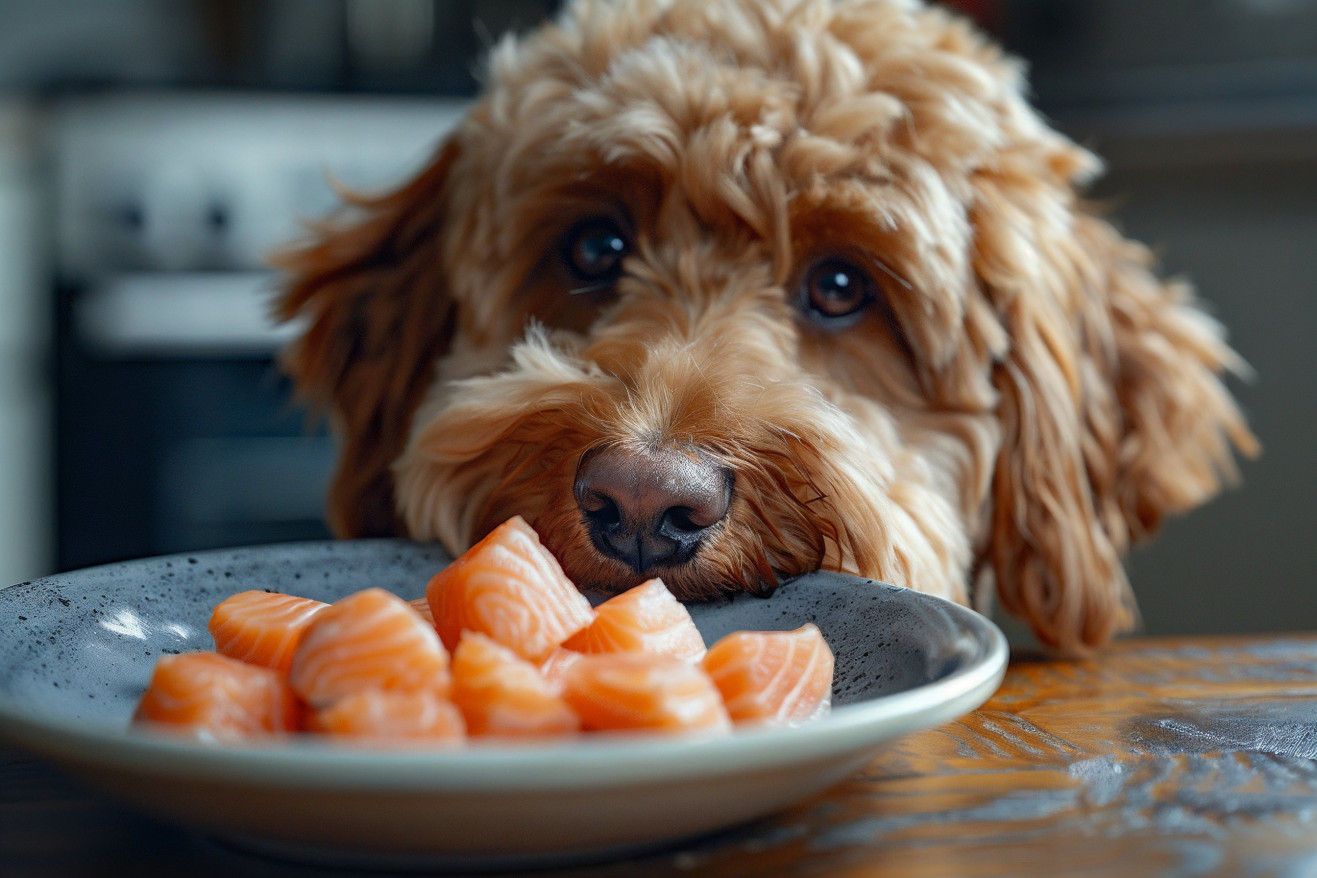How to Cook Salmon for Dogs: A Healthy Snack
25 April 2024 • Updated 24 April 2024

Can dogs eat salmon and if so, how should you cook it? Salmon is a great source of protein and omega-3 fatty acids for dogs. The best way to cook salmon for dogs is to bake or grill it without any added oils, seasonings, or sauces. Make sure to remove all the bones to avoid a choking hazard.
We'll discuss the nutritional value of salmon for dogs and share evidence-based advice from veterinarians about the best ways to cook salmon for your pet. You'll also learn about portion control based on your dog's weight and activity level. Finally, we'll cover any medical issues or dietary needs to make sure your dog can enjoy salmon as a healthy, occasional snack.
Is cooked salmon a healthy snack for dogs?
Raw Salmon Can Cause Salmon Poisoning Disease
Raw or undercooked salmon may harbor a parasitic flatworm that hosts a potentially deadly bacteria, according to research cited by Alaskan Salmon Co. that can lead to salmon poisoning disease in dogs, a serious and often fatal illness. Symptoms of salmon poisoning disease can include vomiting, diarrhea, fever, lethargy, and dehydration, according to VCA Animal Hospitals.
The disease can be diagnosed by veterinarians who find parasite eggs in the dog's feces and is treated with antibiotics and anti-parasitic drugs, VCA Animal Hospitals reports. Despite the many health advantages of salmon for dogs, PetMD warns that raw or undercooked salmon should be fed to dogs with caution because of the risk of salmon poisoning disease.
To avoid this life-threatening illness, it's important to cook salmon thoroughly before giving it to dogs. Cooking salmon completely will ensure that dogs are not exposed to the parasites and bacteria that cause salmon poisoning disease.
How to Cook Salmon for Dogs
In order to safely prepare salmon for dogs, it's important to cook it thoroughly. As noted in How to Cook Salmon for Dogs: Easy Recipes for Food & Treats, the fish should reach an internal temperature of 145°F (63°C) to eliminate any bacteria or parasites.
The article lists several cooking options, such as baking, grilling, broiling, or steaming the salmon. Meanwhile, How To Cook Salmon For Dogs - Recipes.net warns against frying and using oils, seasonings, or sauces, all of which can be toxic to dogs. It also notes that it's important to remove all the bones from the salmon after it's been cooked to avoid a choking hazard.
Finally, Can Dogs Eat Salmon? A Pet Nutrition Expert Weighs In suggests letting the salmon cool down to room temperature before giving it to your dog to eat. This will ensure that it's safe and comfortable for your furry friend to consume.
How Much and How Often Can Dogs Have Salmon?
Salmon is best given to dogs as a treat and not a regular part of their diet, says Pure Pet Food. The site recommends giving up to 10g of salmon per 500g of a dog's body weight once a week. For small dogs, that means 1-2 tablespoons of cooked salmon per serving, while larger dogs can have 2-4 tablespoons per serving, according to Daily Paws.
However, salmon should make up no more than 10% of a dog's daily calorie intake to prevent stomach upset, according to Purina.
Salmon Skin: A Tasty, Crunchy, and Healthy Snack
Salmon skin is an excellent source of omega-3 fatty acids, which are important for a dog's well-being, says How To Cook Salmon Skin For Dogs - Recipes.net. Omega-3 fatty acids can help boost the immune system, contribute to a shiny coat and healthy skin, and support cognitive health. In addition, salmon skin is packed with protein, which can be a great addition to your dog's diet.
To make salmon skin treats, Recipes.net suggests cleaning the skin, cutting it into small pieces, and then baking or pan-frying it until it's crispy. Crunchy Salmon Skin Dog Treats | Dog Child - Dog Child adds that this crunchy salmon skin recipe is a simple and tasty way to use up the skin from your salmon.
On the other hand, Can Dogs Eat Salmon Skin? Vet-Approved Facts & FAQ – Dogster warns that salmon skin is high in fat, so it should be fed in moderation. In some cases, especially for smaller dogs or dogs with dietary restrictions or health issues, salmon skin may not be a good option at all, so it's important to check with your vet before giving it to your dog.
Whether you make your own or buy them from a pet store, salmon skin treats can be a healthy and delicious alternative to regular dog treats, and they offer a satisfying crunch and a range of nutrients. As always, make sure to keep an eye on your dog when you introduce a new food and adjust portion sizes as necessary.
Salmon Supplements: Oils, Freeze-Dried, and Canned
Salmon oil supplements are a source of omega-3 fatty acids that can be beneficial for dogs, says Salmon for Dogs. These fatty acids can help boost a dog's immune system, maintain a dog's skin and coat, and even enhance cognitive function. Pupford explains that freeze-dried or dehydrated salmon treats are a great option for dogs because they are easy to store and the dehydration process preserves the nutrients and flavors of the salmon.
Canned salmon in water is another way to give dogs salmon, according to The Spruce Pets. However, it's important to make sure you trust the brand and read the ingredient list when using canned salmon to ensure it's a high-quality product that's safe for dogs. This is because, as Salmon for Dogs explains, some salmon oil supplements may not be accurately labeled and may not contain the omega-3 fatty acids they claim to.
No matter which form of salmon you choose, it's important to make sure you give your dog the correct amount by following the serving size or dosage information on the product's label, says Salmon for Dogs.
Conclusion: Everything in Moderation and With Professional Guidance
Salmon can be a healthy and helpful part of a dog's diet if it's prepared and given the right way. However, it's important to make sure it's cooked properly, and to be mindful of portion sizes and frequency to avoid any potential downsides. Always talk to a vet, especially if your dog has any dietary limitations or health issues.
Think of salmon as a special treat or a way to supplement your dog's diet, but not as a main source of food. It's important to make sure that your dog is getting a diet that's tailored to their needs and that's complete and balanced to ensure that they're as healthy as possible.


